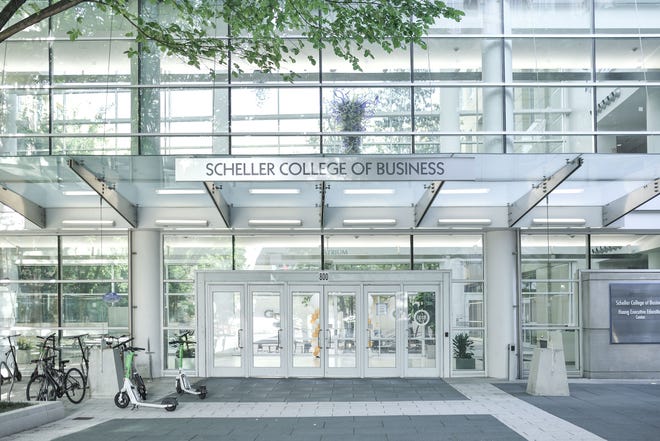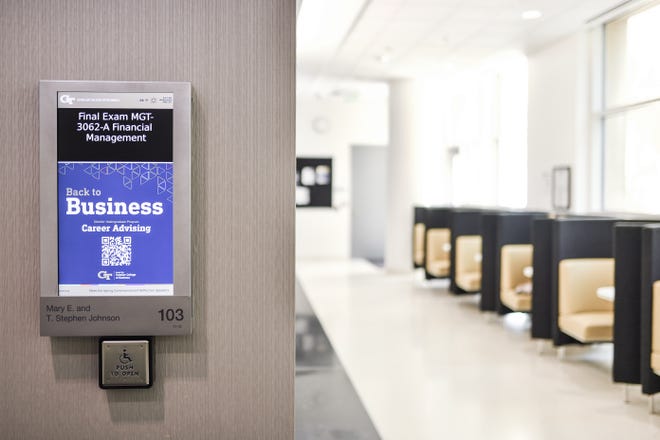During this summer, a team of students from MIT embarked on a journey to the sou …
Universities Concerned About Decline in Graduate Enrollment
Carlos Changemaker

ATLANTA — A significant construction project is taking place near the Scheller College of Business at the Georgia Institute of Technology, with two construction cranes dominating the skyline.
The construction effort not only signifies optimism but also aims to bolster student enrollment, a critical need for universities as they grapple with challenges in graduate education.
The upcoming $200 million development will bring together Scheller’s graduate and executive business programs in one tower, linking them with Georgia Tech’s School of Industrial and Systems Engineering in another. This integration of graduate business programs with other disciplines has yielded positive outcomes, evidenced by Scheller’s decision to include a science, technology, engineering, and math designation in its master’s program in business administration. This move has led to a surge in applications, according to the school.
For a technology-focused university, this strategic alignment seemed inevitable, especially as universities observe signs of uncertainty in the steady growth of graduate enrollment, which has served as a crucial revenue stream. As the costs of graduate schooling come under scrutiny and alternative educational options emerge, universities are reevaluating their approach to attracting and retaining graduate students.
“What we’re seeing now is a combination of a leveling off and a big question mark as to where this long-term trend will go,” explained Brian McKenzie, director of research at the Council of Graduate Schools.

While undergraduate enrollment has seen a continuous decline, graduate enrollment has experienced a notable increase over the past decade. According to the National Center for Education Statistics, undergraduate numbers dropped by 15% between 2010 and 2021, whereas graduate enrollment grew by 9%. This growth was fueled, in part, by a policy change in 2007 that allowed graduate students to borrow up to the full cost of their education.
Universities recognized the potential financial benefits of expanding their graduate offerings as graduate programs became a lucrative revenue source. However, despite a surge in graduate enrollment during the pandemic, the trend reversed in 2022, with a modest recovery seen in the fall of 2023, mainly driven by international student enrollment.
With a projected decline in the number of 18-year-old Americans impacting undergraduate enrollment, graduate programs may also face challenges in the future.

In the midst of growing graduate programs, universities faced a decrease in the number of students per program despite overall growth in enrollment. Additionally, a robust job market has deterred some individuals from pursuing further education, opting instead to capitalize on immediate employment opportunities.
The proliferation of alternative educational pathways, such as short-term certificate programs and nondegree offerings, has provided students with more flexible and cost-effective options than traditional graduate degrees.
“People want something easy, something fast,” stated Lily Bi, president and CEO of the Association to Advance Collegiate Schools of Business, referring to the evolving preferences of students in today’s educational landscape.
Moreover, the shift towards online offerings in graduate education has witnessed a significant increase, providing students with greater flexibility in choosing when and where to pursue their studies.
Despite representing a smaller proportion of all students, graduate students account for a substantial share of federal student borrowing, with the average federal loan holder owing $70,000 toward their graduate education.
These borrowing trends have raised concerns about the potential financial burden faced by graduate students upon completion of their programs.

Recognizing these challenges, the Council of Graduate Schools has initiated efforts to address the cost of graduate education, advocating for policy changes such as expanding Pell Grant eligibility and lowering graduate student loan interest rates.
As universities navigate fluctuating domestic enrollment numbers, they are increasingly relying on international graduate students to sustain growth in graduate programs. The rise in international student enrollment has compensated for declines in domestic enrollment, especially in graduate business schools.
Despite the risk associated with overdependence on international students, universities continue to recruit them vigorously, aiming to capitalize on their contribution to the education system.

Furthermore, the integration of STEM designations in graduate business programs has emerged as a strategic move to attract international students, enabling them to pursue employment opportunities in the United States after graduation.
As universities continue to adapt to the evolving landscape of graduate education, they are exploring innovative approaches to increase student enrollment and address the growing demand for skilled professionals.
Addressing the shortfall in workers for graduate-level positions and ensuring broader participation in graduate education remain key priorities for universities amidst shifting enrollment trends.
The Hechinger Report


